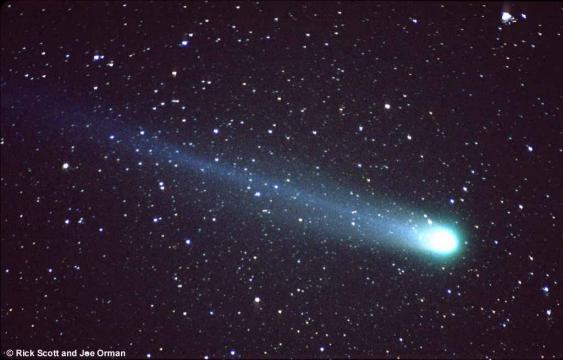Credit & Copyright: R. Scott and J. Orman
Explanation:
Comets are cosmic icebergs.
They follow very elongated orbits
which carry them from the frozen, remote outer reaches of the Solar System
to close encounters with the Sun.
Heated by sunlight, they slough off layers
of material as
gas and dust, forming their characteristic
awe-inspiring comas (heads) and tails.
In the spring of 1996,
Comet Hyakutake inspired Arizona
photographers Rick Scott
and Joe Orman to take this picture
showing faint stars near
the constellation Ursa Minor
(the Little Dipper) shining through the comet's long, graceful tail.
Blown by the solar wind,
comet tails
generally point
away from the Sun.
1999 2000 2001 2002 2003 2004 2005 2006 2007 2008 2009 2010 2011 2012 2013 2014 2015 2016 2017 2018 2019 2020 2021 2022 2023 2024 2025 |
Yanvar' Fevral' Mart Aprel' Mai Iyun' Iyul' Avgust Sentyabr' Oktyabr' Noyabr' Dekabr' |
NASA Web Site Statements, Warnings, and Disclaimers
NASA Official: Jay Norris. Specific rights apply.
A service of: LHEA at NASA / GSFC
& Michigan Tech. U.
|
Publikacii s klyuchevymi slovami:
comet Hyakutake - comet tail - kometa Hiyakutake - kometnye hvosty - komety
Publikacii so slovami: comet Hyakutake - comet tail - kometa Hiyakutake - kometnye hvosty - komety | |
Sm. takzhe:
Vse publikacii na tu zhe temu >> | |
